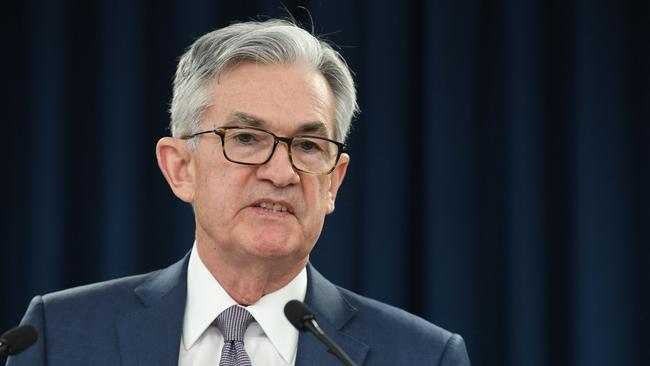Fed tees up taper and signals rate rises possible next year
The Fed signalled it could start reversing its stimulus programs in November and could raise interest rates next year.

The Federal Reserve signalled it could start reversing its pandemic stimulus programs in November and could raise interest rates next year.
The Fed’s rate-setting committee revised its postmeeting statement Wednesday to say that it could start to reduce, or taper, its $US120 billion in monthly asset purchases as soon as its next scheduled meeting, November 2-3.
“If progress continues broadly as expected, the committee judges that a moderation in the pace of asset purchases may soon be warranted,” the statement said.
Fed Chairman Jerome Powell added during a news conference Wednesday that officials generally agreed at their meeting that “a gradual tapering process that concludes around the middle of next year is likely to be appropriate.”
New projections released at the end of the Fed’s two-day policy meeting showed half of 18 officials expect to raise interest rates by the end of 2022. In June, just seven officials anticipated that, with most instead pencilling in rate rises in 2023.
The Fed cut its short-term benchmark rate to near zero when the coronavirus pandemic hit the U.S. economy in March 2020, and it has been purchasing at least $US80 billion a month in Treasury and $US40 billion a month in mortgage bonds since June 2020 to provide additional stimulus.
Fed officials laid out a three-part test to raise interest rates one year ago that would require inflation to reach 2 per cent and be on course to exceed that while the labour market returns to levels consistent with maximum employment.
In December, they said they would buy bonds at the current pace until the economy had made “substantial further progress” toward their goals of reversing a shortfall then of around 10 million jobs since the start of the pandemic and moving inflation back to their 2 per cent goal over time. The Fed’s asset portfolio has doubled to $US8.4 trillion from $US4.2 trillion in February 2020.
Rising vaccination rates and nearly $US2.8 trillion in federal spending approved since
A recent spike in coronavirus cases due to the more transmissible Delta variant has further clouded the outlook in recent months by potentially intensifying conflicting challenges of slower growth and higher inflation.
Mr. Powell has said he was among a majority of officials at their meeting in July, who concluded that they had met their inflation progress test for tapering asset purchases. That leaves the employment shortfall as the remaining hurdle for a taper. The economy has added around 4.7 million jobs this year through August—closing not quite half of the shortfall that existed in December.
The unemployment rate has fallen to 5.2 per cent in August from 6.7 per cent in December. Officials will see one more monthly employment report before their next meeting.
Mr. Powell has dismissed talk about rate increases by describing the thresholds for raising rates as more stringent than those to reduce bond purchases. But getting that message to stick could be tricky because new interest-rate projections—the so-called dot-plot—show officials are eyeing more interest-rate increases.
In June, the dot-plot surprised investors by showing most of the officials expected to raise interest rates by at least a half percentage point in 2023. Their March projections showed most didn’t see any increases through 2023.
The projections released Wednesday show half of the officials expected interest rates would need to rise at least 1 percentage point from their current level by the end of 2023, and by another three-quarters of a percentage point in 2024.
Fed officials agree that they want to end their bond-buying program before they raise rates, but they have been divided over how quickly to proceed.
Several officials have pushed to start tapering soon because they are more concerned about higher inflation and want to position the Fed to raise interest rates next year, if needed. Another group has been more cautious, with some pointing to risks that rising Covid-19 cases could sap hiring momentum.
Officials revised higher their expectations of inflation on Wednesday, and their statement described inflation as “elevated.” Most officials now see core inflation rising to 3.7 per cent at the end of this year, up from a forecast of 3 per cent in June. Officials see inflation slowing to 2.3 per cent in 2022, up from 2.1 per cent in June, and to 2.2 per cent in 2023, also up from 2.1 per cent in June.
The projections show how the Delta variant of the coronavirus and continued supply shortages have dented growth forecasts. Officials now see gross domestic product rising 5.9 per cent this year, down from 7 per cent in the June projections. They see unemployment holding at around 4.8 per cent in the fourth quarter, up from 4.5 per cent in June projections.
Even if Fed officials remain confident that inflationary pressures should fade on their own, the projections indicated more of them see greater risks of higher-than-anticipated inflation than lower-than-anticipated inflation.
There are also questions about whether the pandemic has given workers more power to bargain for higher wages and businesses more ability to pass along higher prices to consumers. Fed officials this summer said they expected the supply of workers to increase as children return to in-person school, unemployment benefits expire and concerns about the virus recede.
The Delta variant has potentially muddied that more-favourable scenario, raising the prospect that continued supply chain disruptions and difficulty in competing for workers could lead to a longer period of shortages and rising prices.
The Wall Street Journal



To join the conversation, please log in. Don't have an account? Register
Join the conversation, you are commenting as Logout